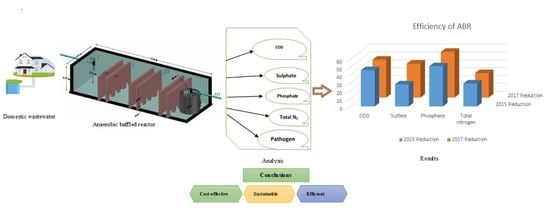Performance Evaluation of a Field-Scale Anaerobic Baffled Reactor as an Economic and Sustainable Solution for Domestic Wastewater Treatment
Abstract
:1. Introduction
2. Materials and Methods
2.1. Unit Design and Experimental Setup
2.2. Start-Up and Operation
2.3. Sampling and Storage of Wastewater
2.4. Microbiological Analysis
2.5. Physicochemical Analyses
3. Results
3.1. Comparative Analysis of ABR Efficiency for Two Years
3.1.1. Reduction in Chemical Oxygen Demand and Sulfates
3.1.2. Reduction in Phosphate and TKN
3.1.3. Reduction in Pathogen Count
3.1.4. Comparison of Years and Statistical Significance
4. Discussion
5. Conclusions
Supplementary Materials
Author Contributions
Funding
Institutional Review Board Statement
Informed Consent Statement
Data Availability Statement
Conflicts of Interest
References
- Ptak-Wojciechowska, A.; Januchta-Szostak, A.; Gawlak, A.; Matuszewska, M. The Importance of Water and Climate-Related Aspects in the Quality of Urban Life Assessment. Sustainability 2021, 13. [Google Scholar] [CrossRef]
- Hamrang, F.; Shokri, A.; Mahmoudi, S.M.S.; Ehghaghi, B.; Rosen, M.A. Performance Analysis of a New Electricity and Freshwater Production System Based on an Integrated Gasification Combined Cycle and Multi-Effect Desalination. Sustainability 2020, 12. [Google Scholar] [CrossRef]
- Jaramillo, M.; Restrepo, I. Wastewater reuse in agriculture: A review about its limitations and benefits. Sustain. Sci. Pract. Policy 2017, 9. [Google Scholar] [CrossRef] [Green Version]
- Mahfooz, Y.; Yasar, A.; Guijian, L.; Yousaf, B.; Sohail, M.T.; Khan, S.; Tabinda, A.B.; Rasheed, R.; Mahmood, S.; Khan, M. An assessment of wastewater pollution, treatment efficiency and management in a semi-arid urban area of Pakistan. Desalination Water Treat. 2020, 177, 167–175. [Google Scholar] [CrossRef]
- Arooj, M.F.; Haseeb, F.; Butt, A.I.; Irfan-Ul-Hassan, D.M.; Batool, H.; Kibria, S.; Javed, Z.; Nawaz, H.; Asif, S. A sustainable approach to reuse of treated domestic wastewater in construction incorporating admixtures. J. Build. Eng. 2021, 33. [Google Scholar] [CrossRef]
- Reynaud, N.; Buckley, C.A. The anaerobic baffled reactor (ABR) treating communal wastewater under mesophilic conditions: A review. Water Sci. Technol. 2016, 73, 463–478. [Google Scholar] [CrossRef]
- Hahn, M.J.; Figueroa, L.A. Pilot scale application of anaerobic baffled reactor for biologically enhanced primary treatment of raw municipal wastewater. Water Res. 2015, 87, 494–502. [Google Scholar] [CrossRef]
- Langenhoff, A. Treatment of dilute soluble and colloidal wastewater using an anaerobic baffled reactor: Influence of hydraulic retention time. Water Res. 2000, 34, 1307–1317. [Google Scholar] [CrossRef]
- Arvin, A.; Peyravi, m.; Jahanshahi, M. Fabrication and Evaluation of anaerobic baffle reactor for leachate treatment of Sari province. J. Environ. Sci. Technol. 2017, 19, 159–171. [Google Scholar]
- Musa, M.A.; Idrus, S. Physical and biological treatment technologies of slaughterhouse wastewater: A review. Sustain. Sci. Pract. Policy 2021, 13. [Google Scholar] [CrossRef]
- Putra, A.A.; Watari, T.; Maki, S.; Hatamoto, M.; Yamaguchi, T. Anaerobic baffled reactor to treat fishmeal wastewater with high organic content. Environ. Technol. Innov. 2020, 17. [Google Scholar] [CrossRef]
- Zhang, C.; Zhang, G.; Wu, F.; Zhou, T. Effect of Elastic Filler on pollutant removal in each compartment of ABR. Sustain. Sci. Pract. Policy 2020, 12. [Google Scholar] [CrossRef] [Green Version]
- Sathe, S.M.; Munavalli, G.R. Domestic wastewater treatment by modified bio-rack wetland system. J. Water Process Eng. 2019, 28, 240–249. [Google Scholar] [CrossRef]
- Lusk, M.; Toor, G.S.; Obreza, T. Onsite sewage treatment and disposal systems: Bacteria and protozoa. IFAS: Gainesville, FL, USA, 2011. [Google Scholar]
- Richards, S.; Paterson, E.; Withers, P.J.A.; Stutter, M. Septic tank discharges as multi-pollutant hotspots in catchments. Sci. Total Environ. 2016, 542, 854–863. [Google Scholar] [CrossRef]
- Withers, P.J.A.; Jordan, P.; May, L.; Jarvie, H.P.; Deal, N.E. Do septic tank systems pose a hidden threat to water quality? Front. Ecol. Environ. 2014, 12, 123–130. [Google Scholar] [CrossRef]
- Yenji, S.S.; Munavalli, G.R.; Koli, M.M. Field-scale anaerobic baffled reactor for domestic wastewater treatment: Effect of dynamic operating conditions. Water Pract. Technol. 2021, 16, 42–58. [Google Scholar] [CrossRef]
- Grand, D.M.D.; Brian , D. ISCO Open Channel Flow Measurement Handbook, 5th ed.; Isco: Geneva, Switzerland, 2001. [Google Scholar]
- Droste, R.L.; Gehr, R.L. Theory and Practice of Water and Wastewater Treatment; John Wiley & Sons: Hoboken, NJ, USA, 2018; p. 992. [Google Scholar]
- American Public Health, A. Standard Methods for the Examination of Water & Wastewater; Ignatius Press: San Francisco, CA, USA, 2005; p. 8. [Google Scholar]
- Bodkhe, S.Y. A modified anaerobic baffled reactor for municipal wastewater treatment. J. Environ. Manage. 2009, 90, 2488–2493. [Google Scholar] [CrossRef]
- Vossoughi, M.; Shakeri, M.; Alemzadeh, I. Performance of anaerobic baffled reactor treating synthetic wastewater influenced by decreasing COD/SO4 ratios. Chem. Eng. Process. Process Intensif. 2003, 42, 811–816. [Google Scholar] [CrossRef]
- Barrera, E.L.; Spanjers, H.; Dewulf, J.; Romero, O.; Rosa, E. The sulfur chain in biogas production from sulfate-rich liquid substrates: A review on dynamic modeling with vinasse as model substrate. J. Chem. Technol. Biotechnol. 2013, 88, 1405–1420. [Google Scholar] [CrossRef]
- Feng, H.J.; Hu, L.F.; Shan, D.; Fang, C.R.; Shen, D.S. Effects of temperature and hydraulic residence time (HRT) on treatment of dilute wastewater in a carrier anaerobic baffled reactor. Biomed. Environ. Sci. 2008, 21, 460–466. [Google Scholar] [CrossRef]
- Hendrasarie, N.; Trilta, M.N. Removal of nitrogen-phosphorus in food wastewater treatment by the Anaerobic Baffled Reactor (ABR) and Rotating Biological Contactor (RBC). IOP Conf. Ser. Earth Environ. Sci. 2019, 245. [Google Scholar] [CrossRef]
- Zhang, N.; Peng, H.; Li, Y.; Yang, W.; Zou, Y.; Duan, H. Ammonia determines transcriptional profile of microorganisms in anaerobic digestion. Braz. J. Microbiol. 2018, 49, 770–776. [Google Scholar] [CrossRef]
- Colleran, E.; Pender, S. Mesophilic and thermophilic anaerobic digestion of sulphate-containing wastewaters. Water Sci. Technol. 2002, 45, 231–235. [Google Scholar] [CrossRef]
- Yulistyorini, A.; Camargo-Valero, M.; Sukarni, S.; Suryoputro, N.; Mujiyono, M.; Santoso, H.; Tri Rahayu, E. Performance of anaerobic baffled reactor for decentralized wastewater treatment in urban Malang, Indonesia. Processes 2019, 7. [Google Scholar] [CrossRef] [Green Version]
- Ahsan, S.; Rahman, M.A.; Kaneco, S.; Katsumata, H.; Suzuki, T.; Ohta, K. Effect of temperature on wastewater treatment with natural and waste materials. Clean Technol. Environ. Policy 2005, 7, 198–202. [Google Scholar] [CrossRef]
- Jiang, Y.; McAdam, E.; Zhang, Y.; Heaven, S.; Banks, C.; Longhurst, P. Ammonia inhibition and toxicity in anaerobic digestion: A critical review. J. Water Process Eng. 2019, 32. [Google Scholar] [CrossRef]
- Nachaiyasit, S.; Stuckey, D.C. Microbial response to environmental changes in an Anaerobic Baffled Reactor (ABR). Antonie Van Leeuwenhoek 1995, 67, 111–123. [Google Scholar] [CrossRef] [PubMed]
- Barber, W.P.; Stuckey, D.C. The Influence of Start-Up Strategies on the Performance of an Anaerobic Baffled Reactor. Environ. Technol. 1998, 19, 489–501. [Google Scholar] [CrossRef]
- Langenbach, K.; Kuschk, P.; Horn, H.; Kastner, M. Modeling of slow sand filtration for disinfection of secondary clarifier effluent. Water Res. 2010, 44, 159–166. [Google Scholar] [CrossRef] [PubMed]
- Pfannes, K.R.; Langenbach, K.M.W.; Pilloni, G.; Stuhrmann, T.; Euringer, K.; Lueders, T.; Neu, T.R.; Muller, J.A.; Kastner, M.; Meckenstock, R.U. Selective elimination of bacterial faecal indicators in the Schmutzdecke of slow sand filtration columns. Appl. Microbiol. Biot. 2015, 99, 10323–10332. [Google Scholar] [CrossRef]
- Tchobanoglous, G.; Burton, F.L.; Stensel, H.D.; Metcalf & Eddy. Wastewater Engineering: Treatment and Reuse, 5th ed.; McGraw-Hill Education: New York, NY, USA, 2013. [Google Scholar]
- Fujihira, T.; Seo, S.; Yamaguchi, T.; Hatamoto, M.; Tanikawa, D. High-rate anaerobic treatment system for solid/lipid-rich wastewater using anaerobic baffled reactor with scum recovery. Bioresour. Technol. 2018, 263, 145–152. [Google Scholar] [CrossRef] [PubMed]
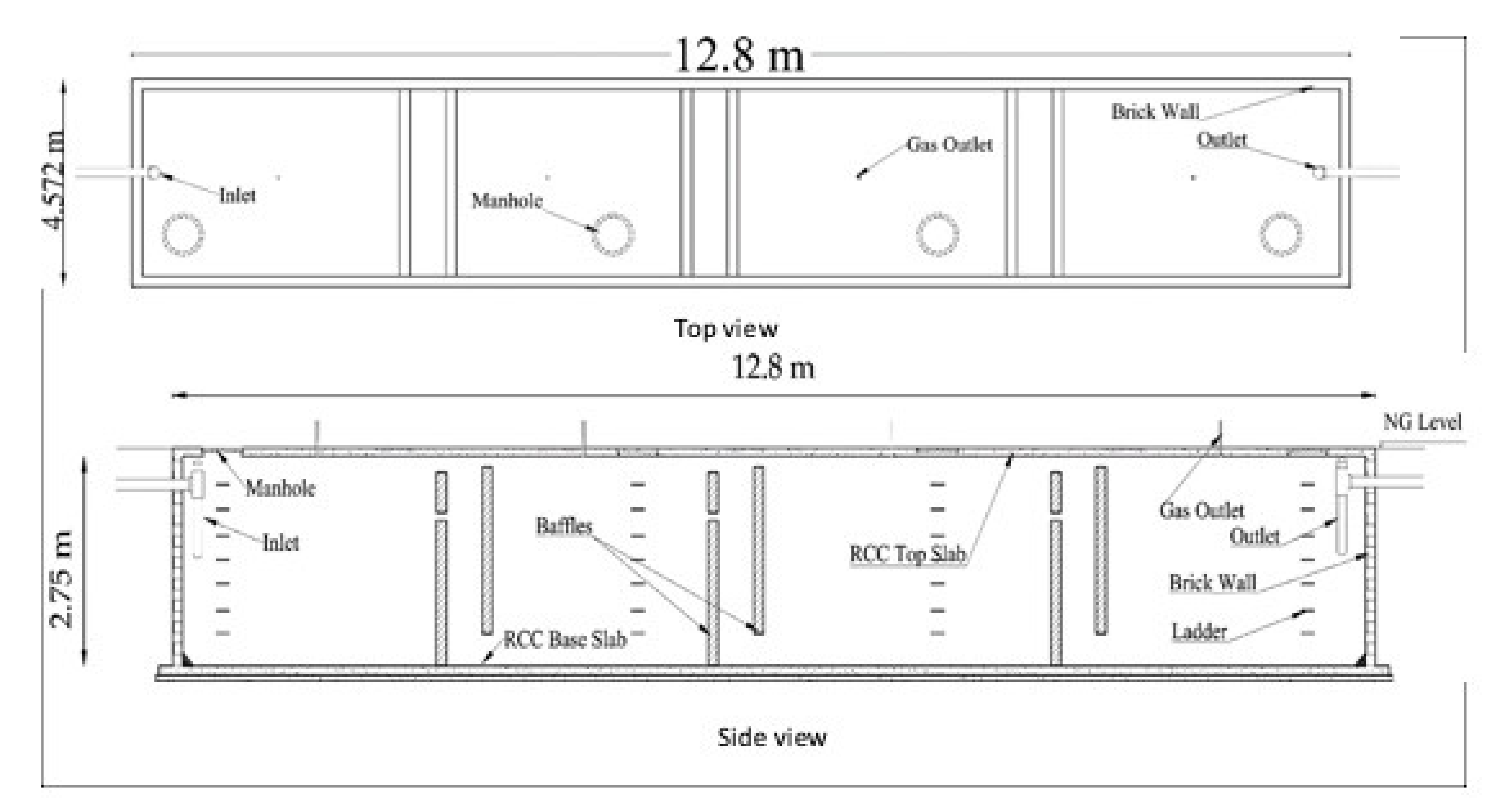
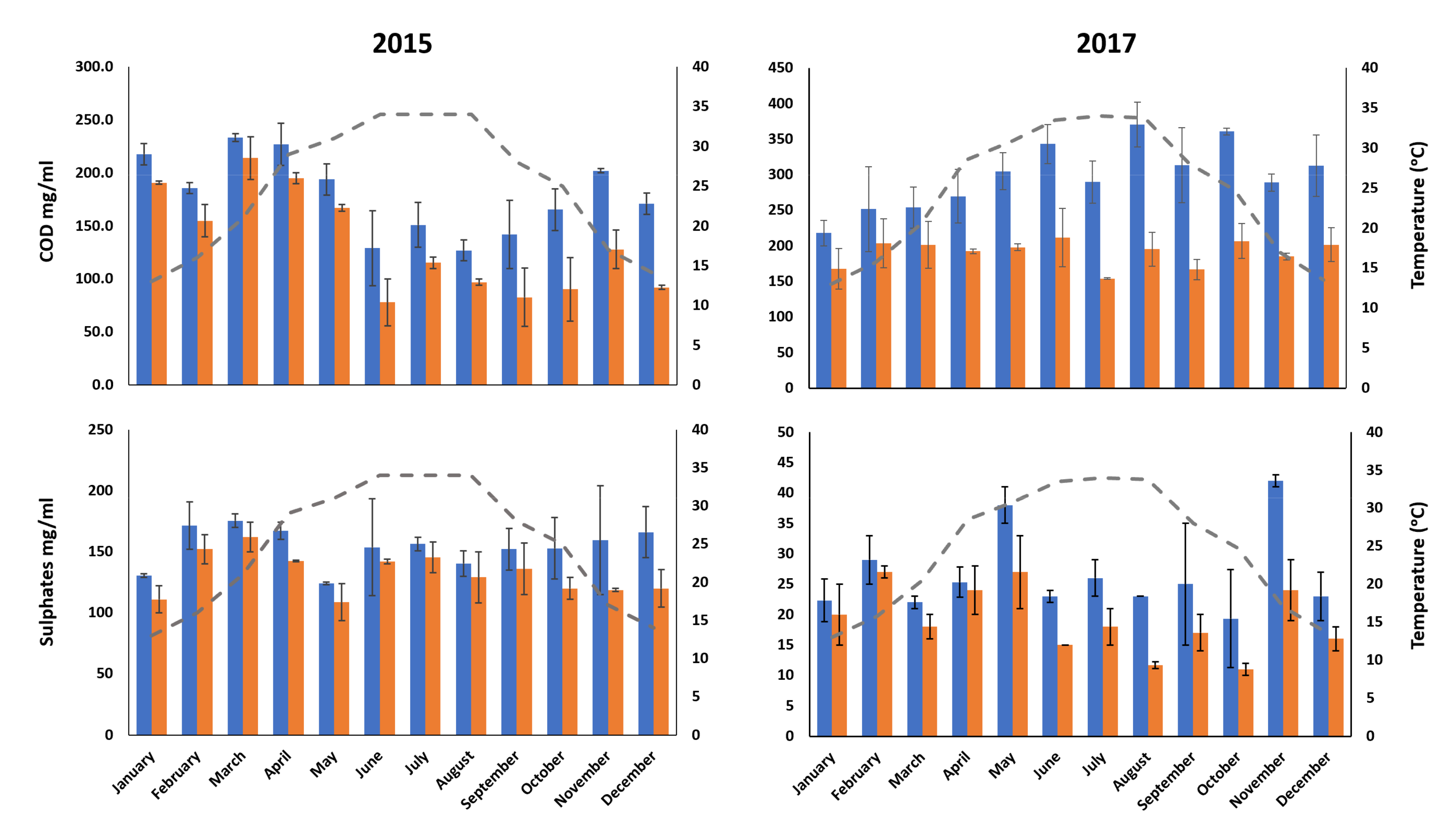
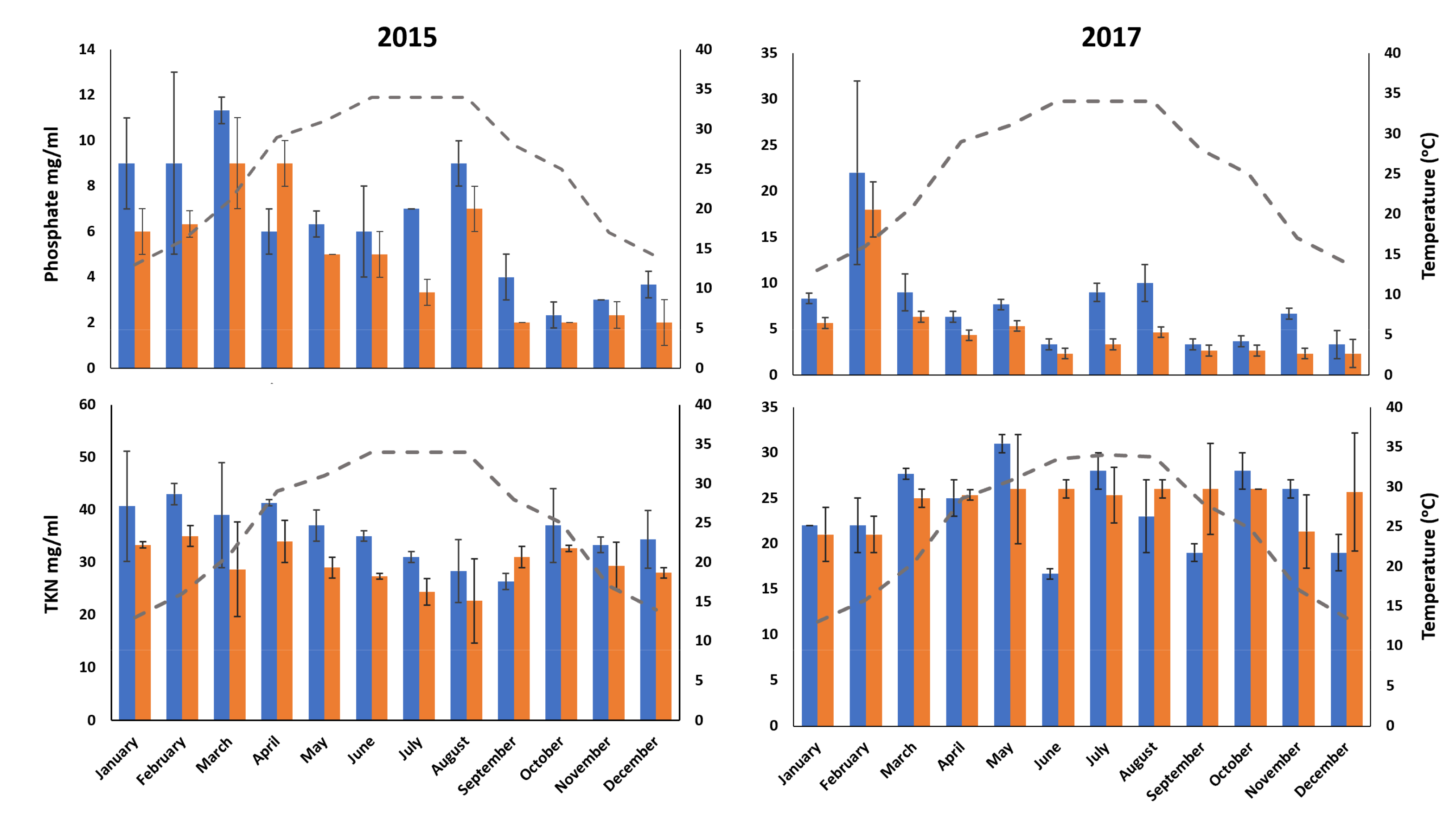
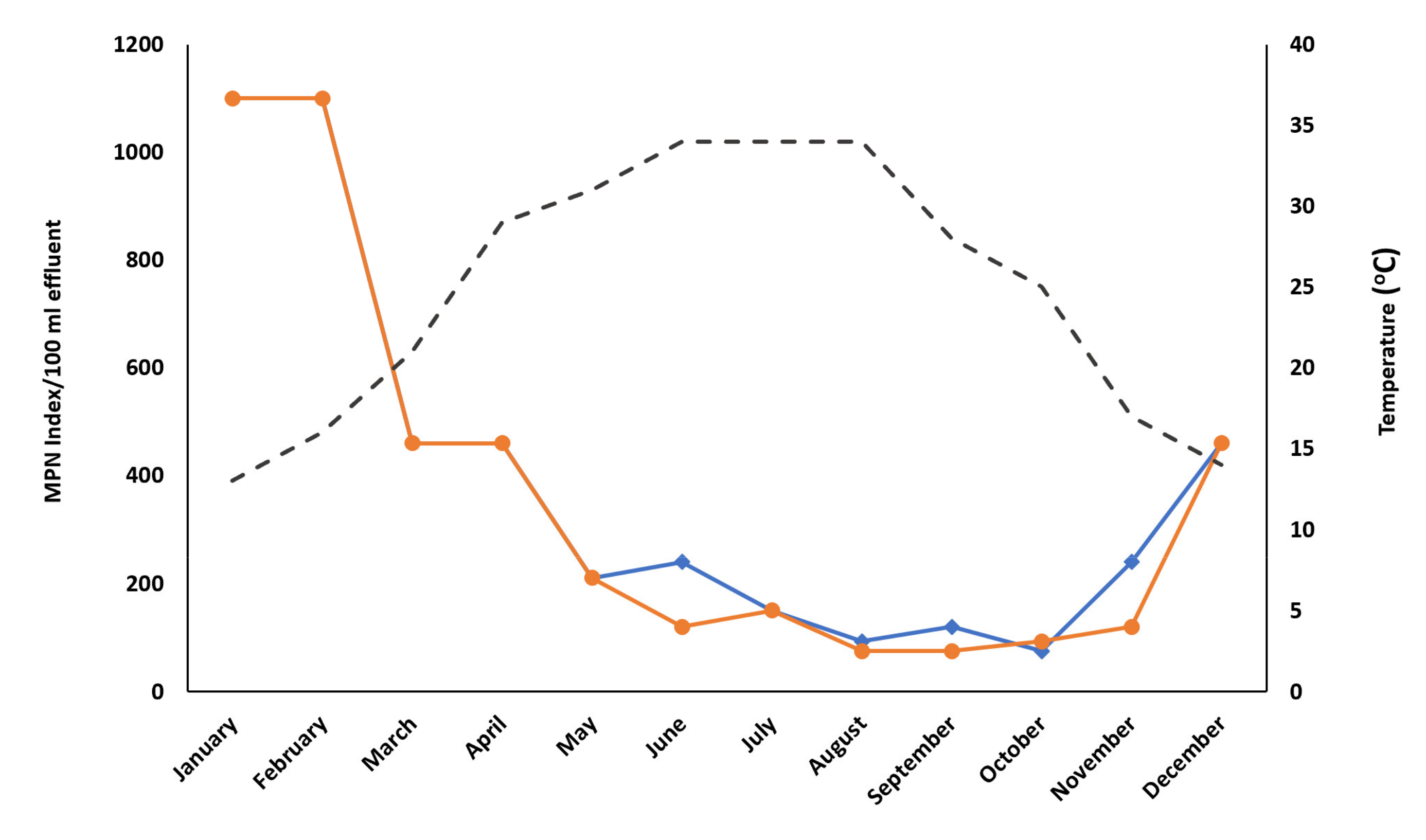
| Month | Jan | Feb | Mar | Apr | May | Jun | Jul | Aug | Sep | Oct | Nov | Dec |
|---|---|---|---|---|---|---|---|---|---|---|---|---|
| 2015 | ||||||||||||
| Flow rate (m3.dL−1) | 91 | 80 | 113 | 146 | 127 | 133 | 129 | 111 | 119 | 102 | 95 | 80 |
| Temp | 13 | 16 | 21 | 29 | 31 | 34 | 34 | 34 | 28 | 25 | 17 | 14 |
| pH influent | 8 | 8 | 8 | 8 | 8 | 8.5 | 7 | 8 | 7 | 7.5 | 7 | 7 |
| pH effluent | 8 | 8 | 8 | 8 | 8 | 8 | 7 | 8 | 7.8 | 7 | 7 | 7 |
| 2017 | ||||||||||||
| Flow rate (m3.dL−1) | 89 | 83 | 101 | 120 | 143 | 150 | 132 | 121 | 108 | 99 | 91 | 84 |
| Temp | 13 | 16 | 21 | 29 | 31 | 34 | 34 | 34 | 28 | 25 | 17 | 14 |
| pH influent | 7.8 | 6.8 | 7.8 | 7 | 6.7 | 7 | 7 | 6.5 | 7 | 6.8 | 7 | 7 |
| pH effluent | 7.7 | 7.2 | 7 | 6 | 7 | 8 | 8 | 8 | 7.6 | 7.7 | 6 | 7 |
| Characteristics | Units | Method | References |
|---|---|---|---|
| COD | mg/L | Closed Reflux Titrimetric method 5220 | [20] |
| Phosphate | mg/L | 4500-P (phosphate) | [20] |
| Sulfates | mg/L | 0375 Barium chrometry | [20] |
| TKN | mg/L | 4500-Norg (organic nitrogen) | [20] |
| Isolate | Morphology | Gram | Citrate | Urease | Catalase | VP | TSI | MR | H2S | Nitrate | Indole | Motility | Identification |
|---|---|---|---|---|---|---|---|---|---|---|---|---|---|
| W1 | RS | – | – | – | + | – | R/Y, H2S | + | – | + | + | + | Shigella |
| W2 | RS | – | + | – | + | – | K/A, H2S | + | + | + | – | + | Salmonella |
| W3 | R | – | + | + | + | – | – | + | + | + | + | + | Proteus spp. |
| W4 | R | – | – | – | + | – | -A/NC | + | – | + | + | + | E. coli |
| W5 | R | - | + | + | + | + | – | – | + | – | – | Klebsiella spp. | |
| W6 | R | – | + | – | + | + | K/A | + | – | + | – | + | Enterobacter spp. |
| Parameter | Year 2015 | Year 2017 | ||||
|---|---|---|---|---|---|---|
| Max Reduction (%) | Month | Temp (°C) | Max Reduction (%) | Month | Temp (°C) | |
| COD | 46.0 | Dec. | 14±2 | 47.6 | Aug. | 34±2 |
| Phosphates | 51.2 | Sept. | 28±2 | 58 | July/Aug. | 34±2 |
| Sulfates | 28.2 | Dec. | 14±2 | 43.5 | Aug. | 34±2 |
| TKN | 29.0 | Aug. | 34±2 | 31.2 | Sept. | 34±2 |
| Parameters | NEQs1 (mg/L) | Influent (mg/L) | Effluent (mg/L) | Tukey HSD | |
| (Mean ±SE) | p-Value | F. ratio | |||
| COD | 150 | (177 ± 7) a | (134 ± 8) b | <0.0001 | 9.5 |
| SO4 2- | 600 | (155 ± 4) a | (133 ± 4) b | 0.0015 | 2.8 |
| PO4 3- | <30 | (6 ± 0.6) a | (5 ± 0.5) b | <0.0001 | 14.3 |
| TKN | - | (37 ± 0.7) a | (30 ± 0.7) b | <0.0001 | 46.8 |
Publisher’s Note: MDPI stays neutral with regard to jurisdictional claims in published maps and institutional affiliations. |
© 2021 by the authors. Licensee MDPI, Basel, Switzerland. This article is an open access article distributed under the terms and conditions of the Creative Commons Attribution (CC BY) license (https://creativecommons.org/licenses/by/4.0/).
Share and Cite
Saif, Y.; Ali, M.; Jones, I.M.; Ahmed, S. Performance Evaluation of a Field-Scale Anaerobic Baffled Reactor as an Economic and Sustainable Solution for Domestic Wastewater Treatment. Sustainability 2021, 13, 10461. https://doi.org/10.3390/su131810461
Saif Y, Ali M, Jones IM, Ahmed S. Performance Evaluation of a Field-Scale Anaerobic Baffled Reactor as an Economic and Sustainable Solution for Domestic Wastewater Treatment. Sustainability. 2021; 13(18):10461. https://doi.org/10.3390/su131810461
Chicago/Turabian StyleSaif, Yasmin, Mahwish Ali, Ian M. Jones, and Safia Ahmed. 2021. "Performance Evaluation of a Field-Scale Anaerobic Baffled Reactor as an Economic and Sustainable Solution for Domestic Wastewater Treatment" Sustainability 13, no. 18: 10461. https://doi.org/10.3390/su131810461
APA StyleSaif, Y., Ali, M., Jones, I. M., & Ahmed, S. (2021). Performance Evaluation of a Field-Scale Anaerobic Baffled Reactor as an Economic and Sustainable Solution for Domestic Wastewater Treatment. Sustainability, 13(18), 10461. https://doi.org/10.3390/su131810461





